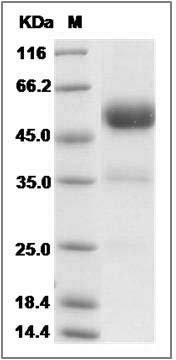-
Product Name
Cynomolgus ALK-1 / ACVRL1 (Fc Tag) recombinant protein
- Documents
-
Description
Activin A receptor, type II-like 1 (ACVRL1), also known as ALK-1 (activin receptor-like kinase 1), is an endothelial-specific type I receptor of the TGF-beta (transforming growth factor beta) receptor family of ligands. On ligand binding, a heteromeric receptor complex forms consisting of two type II and two type I transmembrane serine/threonine kinases. ACVRL1 protein is expressed in certain blood vessels of kidney, spleen, heart and intestine, serving as an important role during vascular development. Mutations in ACVRL1 gene are associated with hemorrhagic telangiectasia type 2, also known as Rendu-Osler-Weber syndrome 2 and vascular disease.
-
Protein short names
TSR-I; AI115505; ACVRL1; R-3; AI427544; MGC91691; ALK-1; SETHKIR; HHT2; ACVRLK1; HHT; ORW2; ALK1; R3; SKR3
-
Source/Expression Host
Human Cells
-
Expression Plasmid/cDNA
A DNA sequence encoding the cynomolgus ACVRL1 (Met1-Gln118) was expressed with the Fc region of human IgG1 at the C-terminus.
-
Protein Species
Cynomolgus
-
Molecular weight
The recombinant cynomolgus ACVRL1 is a disulfide-linked homodimer. The reduced monomer comprises 338 amino acids and has a calculated molecular mass of 37.8 KDa.The apparent molecular mass of the protein is approximately 53 KDa respectively in SDS-PAGE.
-
Purity
> 90 % as determined by SDS-PAGE
-
Activity
Measured by its ability to inhibit BMP9 induced alkaline phosphatase production by MC3T3-E1 cells.
The ED50 for this effect is typically 1-5 ng/ml. -
Validations

Cynomolgus ALK-1 / ACVRL1 Protein (Fc Tag) SDS-PAGE
Related Products / Services
Please note: All products are "FOR RESEARCH USE ONLY AND ARE NOT INTENDED FOR DIAGNOSTIC OR THERAPEUTIC USE"
